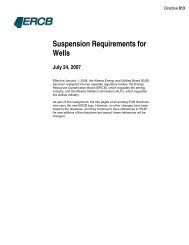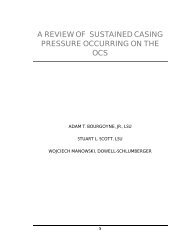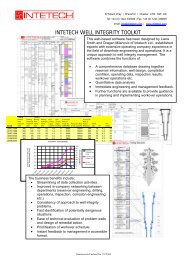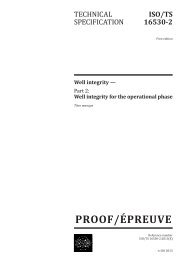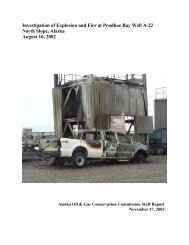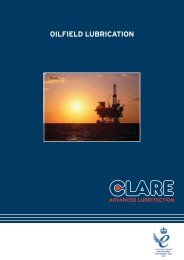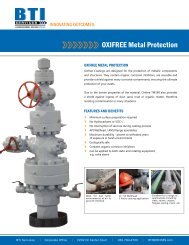Report Investigation of gas blowout on Snorre A - Well Integrity ...
Report Investigation of gas blowout on Snorre A - Well Integrity ...
Report Investigation of gas blowout on Snorre A - Well Integrity ...
You also want an ePaper? Increase the reach of your titles
YUMPU automatically turns print PDFs into web optimized ePapers that Google loves.
The log shows c<strong>on</strong>firmati<strong>on</strong> that the flare was extinguished at 0315 hours. 21<br />
At 0330 hours, the wind had turned to south-southwest, and the force increased to 17-19<br />
knots.<br />
At 0400 hours, 80 m 3 <str<strong>on</strong>g>of</str<strong>on</strong>g> new OBM was mixed and ready. Mud was bullheaded into the well<br />
until they ran empty for the sec<strong>on</strong>d time. After 0530 hours, there was no more OBM <strong>on</strong> board.<br />
Due to the <str<strong>on</strong>g>gas</str<strong>on</strong>g> <strong>on</strong> the sea around the facility, there was no way that the supply boat carrying<br />
mud could come al<strong>on</strong>gside the platform. The following pressures were recorded at that time:<br />
32 bar internal pressure in the work string and 55 bar <strong>on</strong> the annulus side.<br />
At this time, several alternative measures were c<strong>on</strong>sidered: Cementing, use <str<strong>on</strong>g>of</str<strong>on</strong>g> seawater <str<strong>on</strong>g>of</str<strong>on</strong>g><br />
mixing <str<strong>on</strong>g>of</str<strong>on</strong>g> emergency mud with the additives that were available <strong>on</strong> SNA. A decisi<strong>on</strong> was<br />
made to mix up water-based mud (WBM) with the following comp<strong>on</strong>ents: water, barite and<br />
bent<strong>on</strong>ite. Between 0400 - 0915 hours, the crew mixed 160 m 3 <str<strong>on</strong>g>of</str<strong>on</strong>g> water-based mud with a<br />
weight <str<strong>on</strong>g>of</str<strong>on</strong>g> 1.8 s.g.<br />
Only m<strong>on</strong>itoring <str<strong>on</strong>g>of</str<strong>on</strong>g> the well took place from 0530 - 0915 hours.<br />
The emergency management <strong>on</strong> board c<strong>on</strong>sidered the use <str<strong>on</strong>g>of</str<strong>on</strong>g> WBM to be a final attempt to<br />
stop the influx in the well. The purpose <str<strong>on</strong>g>of</str<strong>on</strong>g> waiting to carry out the bullheading was that the<br />
crew wanted to have sufficient volume available during this final bullheading with WBM.<br />
Before starting bullheading with WBM at 0900 hours, SNA requested elevated evacuati<strong>on</strong><br />
preparedness in c<strong>on</strong>necti<strong>on</strong> with a critical phase; for the third time.<br />
Before bullheading with WBM started, a pressure <str<strong>on</strong>g>of</str<strong>on</strong>g> 72 bar was recorded in the annulus and<br />
156 bar in the work string. The bullheading was started at 0915 hours, and at 1022 hours, 0<br />
bar was recorded <strong>on</strong> the annulus side and 0 bar in the work string. At this point, the stores <str<strong>on</strong>g>of</str<strong>on</strong>g><br />
WBM were also empty, <strong>on</strong>ly 8-10m 3 remained as residue in the tanks.<br />
4 POTENTIAL OF THE INCIDENT<br />
4.1 Actual c<strong>on</strong>sequences<br />
The actual c<strong>on</strong>sequences <str<strong>on</strong>g>of</str<strong>on</strong>g> the incident were related to financial loss. The bulk <str<strong>on</strong>g>of</str<strong>on</strong>g> the loss is<br />
related to delayed producti<strong>on</strong> <strong>on</strong> the <strong>Snorre</strong> field. SNA and Vigdis together produce a total <str<strong>on</strong>g>of</str<strong>on</strong>g><br />
approx. 200,000 barrels <str<strong>on</strong>g>of</str<strong>on</strong>g> oil per day. The producti<strong>on</strong> was shut down when the incident<br />
occurred <strong>on</strong> 28 November 2004 and, three m<strong>on</strong>ths later, has still not returned to a normal<br />
level. This is because extensive and costly normalizati<strong>on</strong> measures were required before<br />
producti<strong>on</strong> could be resumed.<br />
Surveys <str<strong>on</strong>g>of</str<strong>on</strong>g> the seabed show a crater measuring 8 x 3 meters <strong>on</strong> the west side <str<strong>on</strong>g>of</str<strong>on</strong>g> the well<br />
template, as well as two craters with diameters <str<strong>on</strong>g>of</str<strong>on</strong>g> 2.5 and 3 meters. In additi<strong>on</strong>, several<br />
smaller craters have been noted towards the northwestern anchor point, while the crater with a<br />
21 See Chapter 7.5 Flaring and depressurizati<strong>on</strong><br />
23



